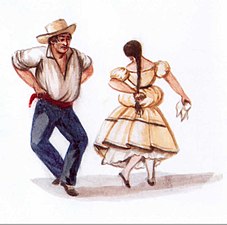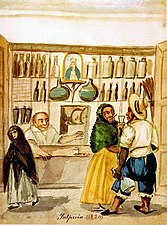Pancho Fierro
This article includes a list of general references, but it lacks sufficient corresponding inline citations. (April 2015) |
You can help expand this article with text translated from the corresponding article in Spanish. (August 2022) Click [show] for important translation instructions.
|

Francisco Fierro Palas, called "Pancho" Fierro (c. 1807/1809, Lima – 28 July 1879, Lima), was a Peruvian painter, known primarily for his costumbrista watercolors, which depict his country's life and customs.
Biography
[edit]He was baptized on 5 February 1809, the son of Nicolás Rodríguez del Fierro, a priest, and a slave from the household of Nicolás' father, Don Antonio, a Colonel in the Militia Battalion.[citation needed] He had been manumitted upon his birth, following a rule that said no son of a Spaniard could be born a slave, but was raised by his mother's family.
There is no record of him receiving any artistic training, so he was probably self-taught. He married in 1828 and made his living by painting signs, making posters for bullfights and molding statues for nativity scenes. He also painted wall murals, all of which have been destroyed or covered over.
Today, he is remembered for his watercolors, painted on sign cards, depicting everyday scenes from Peruvian life. He created over 1200 of them and their popularity produced many imitators. The writer Ricardo Palma owned a large collection which his heirs gave to the City of Lima. They are now on display at the Pinacoteca Municipal Ignacio Merino. The captions were provided by Palma, as Fierro may have been illiterate.[citation needed] Other large collections were acquired by the French painter Léonce Angrand and the Russian ethnographer Leopold von Schrenck, whose collection is now at the "Museum of Anthropology and Ethnography" in the Kunstkamera, Saint Petersburg.[citation needed] He also painted Juan Jose Cabezudo, a gay chef from Lima.[1]
According to an obituary in El Comercio, he died of paralysis in a hospital on Peruvian Independence Day.
Selected watercolors
[edit]-
Peruvian Montonera
-
Dancing the Marinera
-
Water seller
-
Lady bathing at Chorrillos
-
Afro-Peruvians dancing the Zamacueca
Further reading
[edit]- Ferreira, César G. (2003). Culture and customs of Peru. Greenwood Publishing Group. pp. 132–. ISBN 978-0-313-30318-0. Retrieved 17 April 2013.
- Gustavo León y León Durán: Apuntes histórico genealógicos de Francisco Fierro: Pancho Fierro. Biblioteca Nacional del Perú, Fondo Editorial, Lima, 2004. ISBN 9972-874-47-8.
- Manuel Cisneros Sánchez: Pancho Fierro y la Lima del 800, Importadora, Exportadora y Librería García Ribeyro, 1975 ISBN 84-399-4470-5
- Marta Garsd, "Francisco Fierro" in Encyclopedia of Latin American History and Culture, vol. 2, p. 564. New York: Charles Scribner's Sons 1996.
- Raúl Porras Barrenechea and Jaime Bayly: Pancho Fierro, Ediciones del Instituto de Arte Contemporáneo, 1959
- José Sabogal Diéguez: Pancho Fierro: estampas del pintor peruano, Editorial Nova, 1945
References
[edit]- ^ Campuzano, Giuseppe (2008). Museo Travesti del Perú (in Spanish). Museo Travesti del Perú. pp. 56–57. ISBN 978-9972-33-588-4.
External links
[edit]- More watercolors @ the Biblioteca Luis Ángel Arango
- Video Documentary: "Vida y Obras de Pancho Fierro" (narration in Spanish) Part I, Part II, Part III









